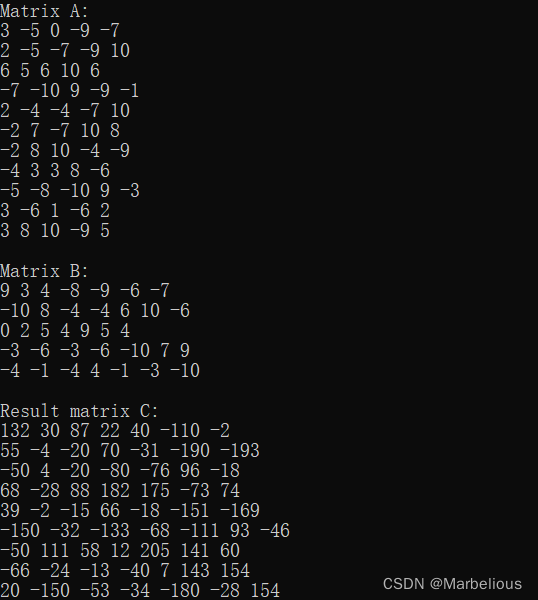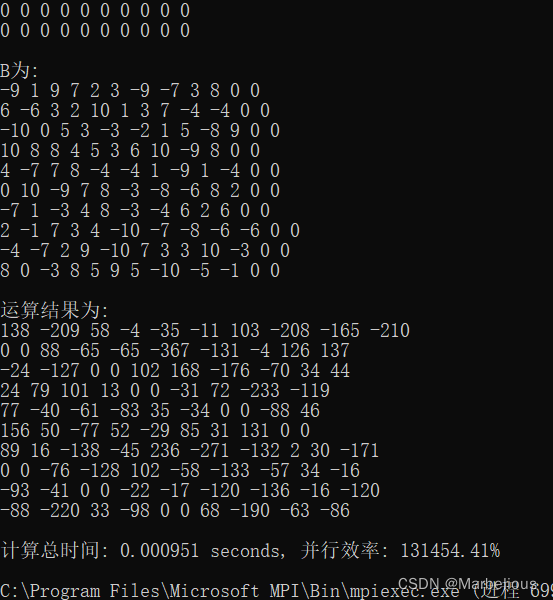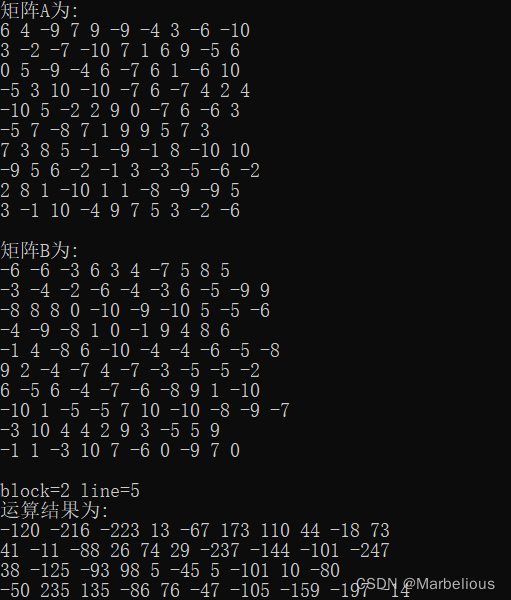课程作业,mpi优化高阶矩阵乘法,分块和卡农参考了博客园上的一个大佬
只实现了A*B两个矩阵相乘
vs2022编译,装了最新版msmpi,线程数一般取10
写了详细的代码注释,希望过段时间还能看懂:(
1.串行代码
#include <stdio.h>
#include <stdlib.h>
#include <time.h>
#define row_a 1024
#define col_a 1024
#define row_b 1024
#define col_b 1024
// 矩阵乘法计算并返回运行时间
double matrix_multiplication(int* arrayA, int* arrayB, int* arrayC) {
clock_t start_time = clock();
for (int x = 0; x < row_a; x++) {
for (int y = 0; y < col_b; y++) {
int sum = 0;
for (int c = 0; c < col_a; c++) {
sum += arrayA[x * col_a + c] * arrayB[c * col_b + y];
}
arrayC[x * col_b + y] = sum;
}
}
clock_t end_time = clock();
return ((double)(end_time - start_time)) / CLOCKS_PER_SEC;
}
int main(void) {
int* arrayA = NULL;
int* arrayB = NULL;
int* arrayC = NULL;
arrayA = (int*)malloc(row_a * col_a * sizeof(int));
arrayB = (int*)malloc(row_b * col_b * sizeof(int));
arrayC = (int*)malloc(row_a * col_b * sizeof(int));
if (arrayA == NULL || arrayB == NULL || arrayC == NULL) {
printf("内存分配失败\n");
return -1;
}
srand((unsigned int)time(NULL));
// 生成并打印矩阵A
printf("矩阵A:\n");
for (int i = 0; i < row_a; i++) {
for (int j = 0; j < col_a; j++) {
arrayA[i * col_a + j] = -10 + rand() % 21;
printf("%d ", arrayA[i * col_a + j]);
}
printf("\n");
}
// 生成并打印矩阵B
printf("矩阵B:\n");
for (int i = 0; i < row_b; i++) {
for (int j = 0; j < col_b; j++) {
arrayB[i * col_b + j] = -10 + rand() % 21;
printf("%d ", arrayB[i * col_b + j]);
}
printf("\n");
}
// 调用矩阵乘法函数并获取运行时间
double total_time = matrix_multiplication(arrayA, arrayB, arrayC, row_a, col_a, col_b);
// 输出运行时间
printf("乘法运行时间: %.4f 秒\n", total_time);
// 释放动态分配的内存
free(arrayA);
free(arrayB);
free(arrayC);
return 0;
}
2.第一版并行代码
优化功能:使用结构体存储数据及其行列大小
平均分发、广播整个矩阵B和平均收集进行并行
缺点:结构体里用了数组,导致矩阵大的时候内存崩溃
平均分发平均收集限制太大,导致线程数必须和矩阵阶数匹配
没有统计效率需要的代码
#include<stdio.h>
#include<mpi.h>
#include<stdlib.h>
#include<time.h>
#define row_a 10
#define column_a 10
#define row_b 10
#define column_b 10
//结构体存储矩阵行列数
typedef struct {
int array[row_a][column_a];
int row;
int column;
}Array;
//随机数生成矩阵
static void create_array(int row, int column, int array[][10]) {
for (int i = 0; i < row; i++) {
for (int j = 0; j < column; j++) {
array[i][j] = -10 + rand() % 21;
}
}
}
//二维数组指针限制了列数
void print_matrix(int array[][10], int row, int column) {
for (int i = 0; i < row; i++) {
for (int j = 0; j < column; j++) {
printf("%d ", array[i][j]);
}
printf("\n");
}
printf("\n");
}
int main(int argc, char* argv[])
{
int rank, size;
MPI_Init(&argc, &argv);
MPI_Comm_rank(MPI_COMM_WORLD, &rank);
MPI_Comm_size(MPI_COMM_WORLD, &size);
int arrayA[row_a][column_a] = { 0 }, arrayB[row_b][column_b] = { 0 }, arrayC[row_a][column_b] = { 0 };
int A_section[column_a] = { 0 };
int C_section[column_a] = { 0 };
if (rank == 0) {
srand((unsigned int)time(NULL));
create_array(row_a, column_a, &arrayA);
create_array(row_b, column_b, &arrayB);
printf("Matrix A:\n");
print_matrix(&arrayA, row_a, column_a);
printf("Matrix B:\n");
print_matrix(&arrayB, row_b, column_b);
}
/*** 分发函数使用方法
参数一:被分发数据的起始位置
参数二:分发大小
参数三:分发数据类型
参数四:接收数据线程的接收地址
参数五:接收的数据大小
参数六:接收数据的类型
参数七:负责分发的线程号
参数八:通信域名称
***/
MPI_Scatter(&arrayA, 10, MPI_INT, &A_section[0], 10, MPI_INT, 0, MPI_COMM_WORLD);
/*** 广播函数使用方法
参数一:被广播数据的起始位置
参数二:广播大小
参数三:广播数据类型
参数四:负责广播的线程号
参数五:通信域名称
***/
MPI_Bcast(&arrayB, row_b * column_b, MPI_INT, 0, MPI_COMM_WORLD);
//printf("我是进程%d, 我的第一个数据为:%d\n", rank, A_section[0]);
// 各个线程运算自己的结果
for (int i = 0; i < column_b; i++) {
C_section[i] = 0;
for (int j = 0; j < column_a; j++) {
C_section[i] += A_section[j] * arrayB[j][i];
}
}
/*** 收集函数使用方法
参数一:被收集数据的起始位置
参数二:收集大小
参数三:被收集的数据类型
参数四:被收集数据存储位置的首地址
参数五:存储的长度
参数六:存储的数据类型
参数七:负责收集存储的线程号
参数八:通信域名称
***/
MPI_Gather(C_section, column_b, MPI_INT, &(arrayC[rank][0]), column_b, MPI_INT, 0, MPI_COMM_WORLD);
if (rank == 0) {
printf("Result matrix C:\n");
print_matrix(&arrayC, 10, 10);
}
MPI_Finalize();
return 0;
}
3.第二版并行代码
优化功能:n*m矩阵的乘法
线程不必再等于A矩阵的行数
缺点:还是二维数组,还是内存崩溃
函数太多太笨重
没有统计效率需要的代码
#include <stdio.h>
#include <mpi.h>
#include <stdlib.h>
#include <time.h>
#define row_a 11
#define column_a 5
#define row_b 5
#define column_b 7
//为了实现m*n的乘法,把两个矩阵的生成分开写了
static void create_arrayA(int row, int column, int array[][column_a]) {
for (int i = 0; i < row; i++) {
for (int j = 0; j < column; j++) {
array[i][j] = -10 + rand() % 21;
}
}
}
static void create_arrayB(int row, int column, int array[][column_b]) {
for (int i = 0; i < row; i++) {
for (int j = 0; j < column; j++) {
array[i][j] = -10 + rand() % 21;
}
}
}
//为了实现m*n的乘法,把两个矩阵的打印也分开写了
void print_matrixA(int arrayA[][column_a], int row, int column) {
for (int i = 0; i < row; i++) {
for (int j = 0; j < column; j++) {
printf("%d ", arrayA[i][j]);
}
printf("\n");
}
printf("\n");
}
void print_matrixB(int arrayB[][column_b], int row, int column) {
for (int i = 0; i < row; i++) {
for (int j = 0; j < column; j++) {
printf("%d ", arrayB[i][j]);
}
printf("\n");
}
printf("\n");
}
//笨重的二维指针
void matrix_multiply(int A[][column_a], int B[][column_b], int C[][column_b], int start_row, int end_row) {
for (int i = start_row; i < end_row; i++) {
for (int j = 0; j < column_b; j++) {
C[i][j] = 0;
for (int k = 0; k < column_a; k++) {
C[i][j] += A[i][k] * B[k][j];
}
}
}
}
int main(int argc, char* argv[]) {
int rank, size;
MPI_Init(&argc, &argv);
MPI_Comm_rank(MPI_COMM_WORLD, &rank);
MPI_Comm_size(MPI_COMM_WORLD, &size);
//笨重的初始化,还是二维数组,因为不能又发又存,为了0线程多创了俩矩阵
int arrayA1[row_a][column_a] = { 0 }, arrayA2[row_a][column_a] = { 0 }, arrayB[row_b][column_b] = { 0 }, arrayC1[row_a][column_b] = { 0 }, arrayC2[row_a][column_b] = { 0 };
if (rank == 0) {
srand((unsigned int)time(NULL));
create_arrayA(row_a, column_a, arrayA1);
create_arrayB(row_b, column_b, arrayB);
printf("Matrix A:\n");
print_matrixA(arrayA1, row_a, column_a);
printf("Matrix B:\n");
print_matrixB(arrayB, row_b, column_b);
}
int rows_per_proc = row_a / size; //均分的话每个进程保底运算几行
int extra_rows = row_a % size; //余下的部分计算任务
/***
*给scatterv做准备:
start_row:分配开始的行数,即前面一共分走了几行,加一即为开始地点
先把均分的总数算出来,余下的先判断一下线程能不能分到,能分到就+1,分不到+0
end_row:分配结束的行数,就是开始的行数加上自己本身分配的行数
***/
int start_row = rank < row_a ? rank * rows_per_proc + (rank < extra_rows ? rank : extra_rows) : 0;
int end_row = rank < row_a ? start_row + rows_per_proc + (rank < extra_rows ? 1 : 0) : 0;
/***
*给scatterv做准备:
send_counts:发送的数据量,就是发送行数*列大小
displs:发送数据的首地址,即偏移量
***/
/***
*给gatherv做准备:
recv_counts:收集的数据量,算出来之后应该是分配的行数*B矩阵的列数
recv_displ:被收集数据存储位置的首地址,即偏移量,算算前面的线程占了多少,往后加就行
***/
//我这里为什么要用动态分配来着,好像是因为size是变量,不能当一维数组用,被迫的
int* send_counts = (int*)malloc(size * sizeof(int));
int* displs = (int*)malloc(size * sizeof(int));
int* recv_counts = (int*)malloc(size * sizeof(int));
int* recv_displs = (int*)malloc(size * sizeof(int));
//这玩意很奇怪,不加报错,加了一次也没这样退出过。。。
if (send_counts == NULL || displs == NULL || recv_counts == NULL || recv_displs == NULL) {
printf("内存分配失败\n");
MPI_Abort(MPI_COMM_WORLD, 1);
}
for (int i = 0; i < size; i++) {
send_counts[i] = (i < row_a) ? (rows_per_proc + (i < extra_rows ? 1 : 0)) * column_a : 0;
displs[i] = (i < row_a) ? i * rows_per_proc * column_a + (i < extra_rows ? i * column_a : extra_rows * column_a) : 0;
recv_counts[i] = (i < row_a) ? (rows_per_proc + (i < extra_rows ? 1 : 0)) * column_b : 0;
recv_displs[i] = (i < row_a) ? i * rows_per_proc * column_b + (i < extra_rows ? i * column_b : extra_rows * column_b) : 0;
}
/*** 不均匀分发函数使用方法
参数一:被分发数据的起始位置
参数二:分发大小,线程间可能不同,按顺序取用数组中的数据
参数三:分发数据在发送区的偏移量
参数四:分发数据类型
参数五:接收缓存区首地址
参数六:接收数据的大小
参数七:接收数据的类型
参数八:负责分发的线程号
参数九:通信域名称
***/
MPI_Scatterv(arrayA1, send_counts, displs, MPI_INT, &arrayA2[start_row][0], (end_row - start_row) * column_a, MPI_INT, 0, MPI_COMM_WORLD);
// 广播矩阵 B 到所有进程
MPI_Bcast(arrayB, row_b * column_b, MPI_INT, 0, MPI_COMM_WORLD);
// 计算部分矩阵乘积
if (rank < row_a) {
matrix_multiply(arrayA2, arrayB, arrayC2, start_row, end_row);
}
/*** 不均匀收集函数使用方法
参数一:被收集数据的起始位置
参数二:收集数据的大小
参数三:收集数据的类型
参数四:被收集数据的缓存区
参数五:收集数据的大小
参数六:收集数据在缓存区储存位置的偏移量
参数七:收集数据的类型
参数八:负责收集的线程号
参数九:通信域名称
***/
MPI_Gatherv(&arrayC2[start_row][0], (end_row - start_row) * column_b, MPI_INT, arrayC1, recv_counts, recv_displs, MPI_INT, 0, MPI_COMM_WORLD);
if (rank == 0) {
printf("Result matrix C:\n");
print_matrixB(arrayC1, row_a, column_b);
}
// 释放动态分配的内存
free(send_counts);
free(displs);
free(recv_counts);
free(recv_displs);
MPI_Finalize();
return 0;
}

4.第三版并行代码
优化功能:矩阵用了动态分配,一维数组指针,妈妈再也不用担心我的内存不够了
分块矩阵乘法,大大减少了通信时间
增加了计算乘法运行时间和计算并行效率的代码
缺点:小型矩阵的乘法不能做了,但这本来就是高阶矩阵乘法对吧
#include <stdio.h>
#include "mpi.h"
#include <stdlib.h>
#include <math.h>
#define row_a 10
#define column_a 10
#define row_b 10
#define column_b 10
#define SERIAL_TIME 5.0 // 假设串行时间为5秒,可以先运行一下串行代码看着改
//学聪明了,一维数组传行列数不就行了,傻子才用二维(恼
static void create_arrayA(int row, int* array) {
for (int i = 0; i < column_a; i++) {
for (int j = 0; j < row; j++) {
if (j < row_a)
array[j * column_a + i] = -10 + rand() % 21;
else
array[j * column_a + i] = 0;
}
}
}
static void create_arrayB(int col, int* array) {
for (int i = 0; i < column_a; i++) {
for (int j = 0; j < col; j++) {
if (j < column_b)
array[i * col + j] = -10 + rand() % 21;
else
array[i * col + j] = 0;
}
}
}
static void print_matrix(int* array, int row, int column) {
for (int i = 0; i < row; i++) {
for (int j = 0; j < column; j++) {
printf("%d ", array[i * column + j]);
}
printf("\n");
}
printf("\n");
}
/***
* 分块矩阵法介绍:
* 两个矩阵,A分成行向量,B分成列向量,A*B的每一项即可看作行列向量的积
* 这样的话就不必广播整个B,而是部分的B,大大缩短通信时间
*
***/
int main(int argc, char** argv)
{
//原始矩阵大小
int M = row_a, N = column_a, K = column_b;
int rank, size;
double start, stop;
MPI_Status status;
MPI_Init(&argc, &argv);
MPI_Comm_size(MPI_COMM_WORLD, &size);
MPI_Comm_rank(MPI_COMM_WORLD, &rank);
// 算高阶,线程数不能比矩阵阶数小,不然就没法分块了
if (size > M || size > K) {
if (rank == 0)
printf("Error: 线程数大于矩阵阶数!\n");
MPI_Finalize();
return 0;
}
// 扩展以致线程均分A的行,B的列
if (M % size != 0) {
M += size - (M % size);
}
//int saveK = K;
if (K % size != 0) {
K += size - (K % size);
}
int each_row = M / size; // 每个线程计算几行A(扩展后,后同
int each_col = K / size; // 每个线程计算几列B(扩展后,后同
// 一维数组指针赛高
int* Matrix_A = NULL;
//A行切片的存储地址,B列切片的存储地址,结果矩阵
int* buffer_A, * buffer_B, * ans, * result_Matrix;
buffer_A = (int*)malloc(each_row * N * sizeof(int)); //分片A,每个线程分几行,N列,想象一下,A横着切,B竖着切
buffer_B = (int*)malloc(N * each_col * sizeof(int)); //分片B,每个线程分几列,N行,
ans = (int*)malloc(each_row * K * sizeof(int)); //保存部分计算结果
result_Matrix = (int*)malloc(M * K * sizeof(int)); //最终结果矩阵
if (buffer_A == NULL || buffer_B == NULL || ans == NULL || result_Matrix == NULL) {
printf("Memory allocation failed\n");
MPI_Abort(MPI_COMM_WORLD, 1);
}
if (rank == 0) {
int* Matrix_B;
Matrix_A = (int*)malloc(M * N * sizeof(int));
Matrix_B = (int*)malloc(N * K * sizeof(int));
if (Matrix_A == NULL || Matrix_B == NULL) {
printf("Matrix memory allocation failed\n");
MPI_Abort(MPI_COMM_WORLD, 1);
}
// 初始化,扩展的部分全置零,不影响计算结果
srand((unsigned int)time(NULL));
create_arrayA(M, Matrix_A);
printf("A为:\n");
print_matrix(Matrix_A, M, N);
create_arrayB(K, Matrix_B);
printf("B为:\n");
print_matrix(Matrix_B, N, K);
//printf("行 blocks: %d, 列 blocks: %d\n", each_row, each_col);
// 加了统计乘法时间的变量
start = MPI_Wtime();
//0线程发之前先把自己的B列块存好
for (int i = 0; i < N; i++) {
for (int j = 0; j < each_col; j++) {
buffer_B[i * each_col + j] = Matrix_B[i * K + j];
}
}
/***
* send函数的用法:
* 参数一:发送区首地址
* 参数二:发送的数据大小
* 参数三:发送的数据类型
* 参数四:接收方的线程号
* 参数五:消息类型,说实话这个译名,不太懂,应该是发的比较多,用来区分接收顺序的
* 参数六:通信域
***/
for (int p = 1; p < size; p++) {
//线程号*每个线程要算的列数=偏移量,因为前面的分给别人了,下面的i*k,分块B是列向量,要分成好几行发,一行发each_col个
for (int i = 0; i < N; i++) {
int beginCol = p * each_col;
MPI_Send(Matrix_B + i * K + beginCol, each_col, MPI_INT, p, i, MPI_COMM_WORLD);
}
}
free(Matrix_B);
}
// 分发函数复习一下?
MPI_Scatter(Matrix_A, each_row * N, MPI_INT, buffer_A, each_row * N, MPI_INT, 0, MPI_COMM_WORLD);
if (rank == 0) {
free(Matrix_A);
}
/***
* recv函数的用法:
* 参数一:接收区首地址
* 参数二:接收的数据大小
* 参数三:发送的数据类型
* 参数四:发送方的线程号
* 参数五:消息类型
* 参数六:通信域
* 参数七:接收状态,没接到报错误状态码
***/
if (rank != 0) {
for (int i = 0; i < N; i++) {
//各个进程接收自己的B列块
MPI_Recv(buffer_B + i * each_col, each_col, MPI_INT, 0, i, MPI_COMM_WORLD, &status);
}
}
/***
* sendrecv_replace函数:使用MPI的发送接收替换函数,将当前线程的B块发送到目标线程,并接收从源线程发来的B块
* 参数一:发送和接收的缓冲区
* 参数二:发送和接收的数据量,即矩阵B的一个分块的大小
* 参数三:数据类型
* 参数四:目标线程的rank号
* 参数五:发送的消息标签
* 参数六:源线程的rank号
* 参数七:接收的消息标签
* 参数八:通信域
* 参数九:MPI通信状态
***/
//每个线程的B列块都不同,算完自己的,就把自己的B发给前一个线程,从后一个线程拿新的B,再算一遍,算十次就算完了
for (int k = 0; k < size; k++) {
//比如线程1,执行到第4次,那就该拿线程4的B,(3+1)%10*each_col,代表应该存到线程4那个列块的位置。
int beginCol = ((k + rank) % size) * each_col;
//行列对应元素相乘
for (int i = 0; i < each_row; i++) {
for (int j = 0; j < each_col; j++) {
int temp = 0;
for (int p = 0; p < N; p++) {
temp += buffer_A[i * N + p] * buffer_B[p * each_col + j];
}
//分片A乘整个B,结果应该是each.row个1*B.col 的向量,前面的i*k是算行,后面在算列,从4B列块的首地址开始,第j个
ans[i * K + beginCol + j] = temp;
}
}
// 计算发送B目标线程的 rank 号。
int dest = (rank - 1 + size) % size;
// 计算获取B源线程的 rank 号。
int src = (rank + 1) % size;
MPI_Sendrecv_replace(buffer_B, N * each_col, MPI_INT, dest, 0, src, 0, MPI_COMM_WORLD, &status);
}
//收集函数复习一下?
MPI_Gather(ans, each_row * K, MPI_INT, result_Matrix, each_row * K, MPI_INT, 0, MPI_COMM_WORLD);
// 算乘法计算总时间和并行效率
if (rank == 0) {
stop = MPI_Wtime();
double E = (SERIAL_TIME / (stop - start)) / size;
printf("运算结果为:\n");
print_matrix(result_Matrix, row_a, column_b);
printf("计算总时间: %lf seconds, 并行效率: %.2lf%%\n", stop - start, 100 * E);
}
// 释放内存
free(buffer_A);
free(buffer_B);
free(ans);
free(result_Matrix);
MPI_Finalize();
return 0;
}

5.第四版并行代码
优化功能:卡农算法,进一步缩短通信时间
缺点:卡农算法适用于n*n矩阵,n*m可以靠扩展解决,但是我懒
线程数必须为完全平方数,限制较大
#include <stdio.h>
#include "mpi.h"
#include <stdlib.h>
#include <math.h>
#include <string.h>
#define row_a 10
#define SERIAL_TIME 5.0 // 假设串行时间为5秒
// 创建矩阵并初始化
static void create_array(int N, int* array) {
for (int i = 0; i < N; i++) {
for (int j = 0; j < N; j++) {
if (i < row_a && j < row_a) {
array[i * N + j] = -10 + rand() % 21;
}
else {
array[i * N + j] = 0;
}
}
}
}
// 打印矩阵
static void print_matrix(int* array, int row, int column) {
for (int i = 0; i < row; i++) {
for (int j = 0; j < column; j++) {
printf("%d ", array[i * column + j]);
}
printf("\n");
}
printf("\n");
}
// 获取对应分块的线程号
int get_index(int row, int col, int block) {
return (row + block) % block * block + (col + block) % block;
}
/***卡农算法计算矩阵A*B ***/
int main(int argc, char** argv)
{
int N = row_a; // 方阵矩阵阶数
int rank, size;
double start, stop;
MPI_Status status;
MPI_Init(&argc, &argv);
MPI_Comm_size(MPI_COMM_WORLD, &size);
MPI_Comm_rank(MPI_COMM_WORLD, &rank);
int block = (int)sqrt(size); // A B行列分多少块,线程数必须可以开方
if (size != block * block || block > N) {
if (rank == 0)
printf("error process:%d\n", size);
MPI_Finalize();
return 0;
}
int saveN = N; // 为了A B能均分,扩展一下
if (N % block != 0) {
N -= N % block;
N += block;
}
int line = N / block; // 矩阵A B每块分多少行or列数据
int my_Row = rank / block; // 每个块当前位置(i,j)
int my_Col = rank % block; // 每个块当前位置(i,j)
int* buffer_A, * buffer_B, * ans;
buffer_A = (int*)malloc(line * line * sizeof(int)); // A的块数据
buffer_B = (int*)malloc(line * line * sizeof(int)); // B的块数据
ans = (int*)malloc(line * line * sizeof(int)); // 临时存储每块的结果数据
if (rank == 0) {
int* Matrix_A, * Matrix_B;
Matrix_A = (int*)malloc(N * N * sizeof(int));
Matrix_B = (int*)malloc(N * N * sizeof(int));
srand((unsigned int)time(NULL));
create_array(N, Matrix_A);
printf("矩阵A为:\n");
print_matrix(Matrix_A, N, N);
create_array(N, Matrix_B);
printf("矩阵B为:\n");
print_matrix(Matrix_B, N, N);
printf("block=%d line=%d\n", block, line);
start = MPI_Wtime();
// 将AB的每块数据分配给每个进程
for (int p = 1; p < size; p++) {
int beginRow = (p / block) * line; // 每个块的行列起始位置(坐标/偏移量)
int beginCol = (p % block) * line;
for (int i = 0; i < line; i++) {
MPI_Send(Matrix_A + (beginRow + i) * N + beginCol, line, MPI_INT, p, 0, MPI_COMM_WORLD);
MPI_Send(Matrix_B + (beginRow + i) * N + beginCol, line, MPI_INT, p, 1, MPI_COMM_WORLD);
}
}
// 线程0自己的部分直接拷贝过去即可
for (int i = 0; i < line; i++) {
memcpy(buffer_A + i * line, Matrix_A + i * N, line * sizeof(int));
memcpy(buffer_B + i * line, Matrix_B + i * N, line * sizeof(int));
}
free(Matrix_A);
free(Matrix_B);
}
else {
// 其他线程接收A B块数据
for (int i = 0; i < line; i++) {
MPI_Recv(buffer_A + i * line, line, MPI_INT, 0, 0, MPI_COMM_WORLD, &status);
MPI_Recv(buffer_B + i * line, line, MPI_INT, 0, 1, MPI_COMM_WORLD, &status);
}
}
// 执行卡农算法,总共block个块,换完就算完了
for (int k = 0; k < block; k++) {
// 计算部分矩阵乘积
for (int i = 0; i < line; i++) {
for (int j = 0; j < line; j++) {
int temp = 0;
for (int p = 0; p < line; p++) {
temp += buffer_A[i * line + p] * buffer_B[p * line + j];
}
if (k == 0)
ans[i * line + j] = temp;
else
ans[i * line + j] += temp;
}
}
// 收发函数复习一下?
// 把矩阵A均分为几个块,把自己的块发给同行但上一列的线程,从同行的下一列那块的线程拿数据
MPI_Sendrecv_replace(buffer_A, line * line, MPI_INT, get_index(my_Row, my_Col - 1, block), 5,
get_index(my_Row, my_Col + 1, block), 5, MPI_COMM_WORLD, &status);
// 把矩阵B均分为几个块,把自己的块发给同列但上一行的线程,从同列的下一行那块的线程拿数据
MPI_Sendrecv_replace(buffer_B, line * line, MPI_INT, get_index(my_Row - 1, my_Col, block), 6,
get_index(my_Row + 1, my_Col, block), 6, MPI_COMM_WORLD, &status);
}
// 发送函数复习一下?
if (rank != 0) {
MPI_Send(ans, line * line, MPI_INT, 0, 7, MPI_COMM_WORLD);
}
else {
// 接收其它进程的计算结果
int* result_Matrix = (int*)malloc(N * N * sizeof(int)); // 保存数据计算结果
for (int i = 0; i < line; i++) {
for (int j = 0; j < line; j++) {
result_Matrix[i * N + j] = ans[i * line + j];
}
}
for (int p = 1; p < size; p++) {
int beginRow = (p / block) * line;
int beginCol = (p % block) * line;
MPI_Recv(ans, line * line, MPI_INT, p, 7, MPI_COMM_WORLD, &status);
for (int i = 0; i < line; i++) {
memcpy(result_Matrix + (beginRow + i) * N + beginCol, ans + i * line, line * sizeof(int));
}
}
printf("运算结果为:\n");
print_matrix(result_Matrix, row_a, row_a);
stop = MPI_Wtime();
printf("rank:%d time:%lfs\n", rank, stop - start);
free(result_Matrix);
}
free(buffer_A);
free(buffer_B);
free(ans);
MPI_Finalize();
return 0;
}
























 604
604











 被折叠的 条评论
为什么被折叠?
被折叠的 条评论
为什么被折叠?








